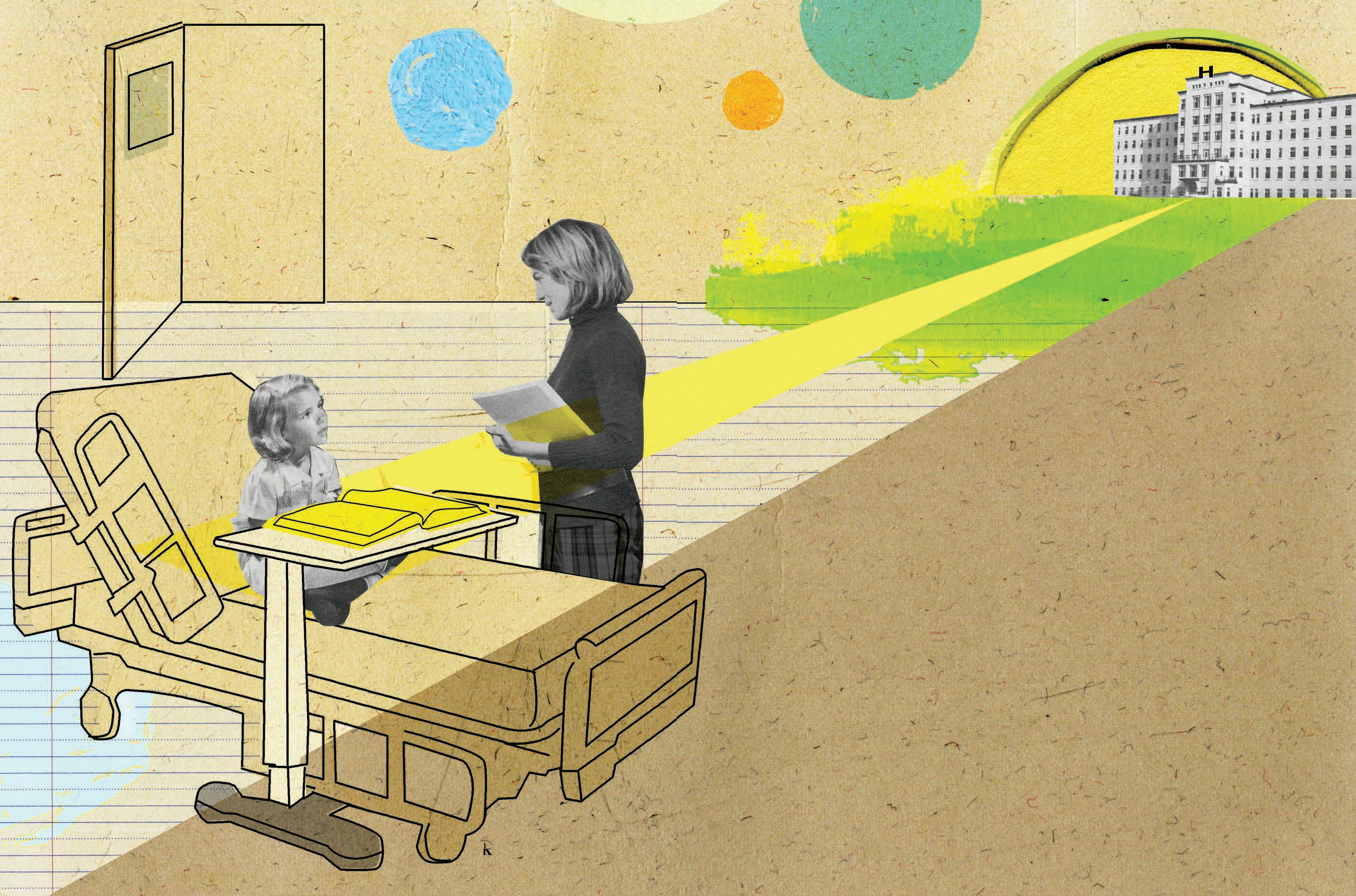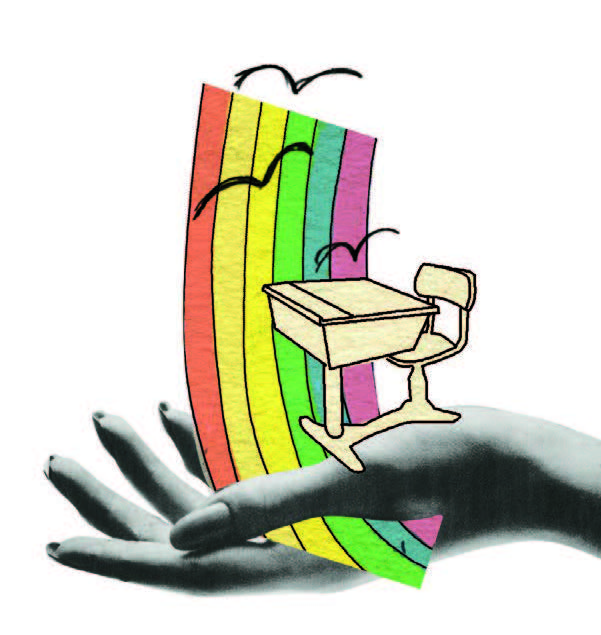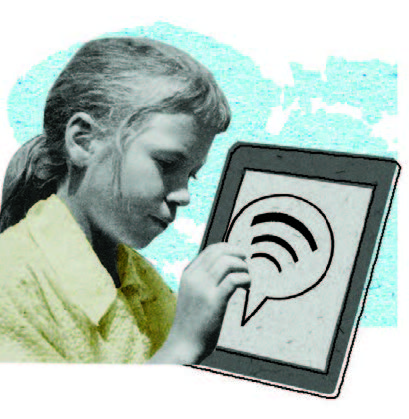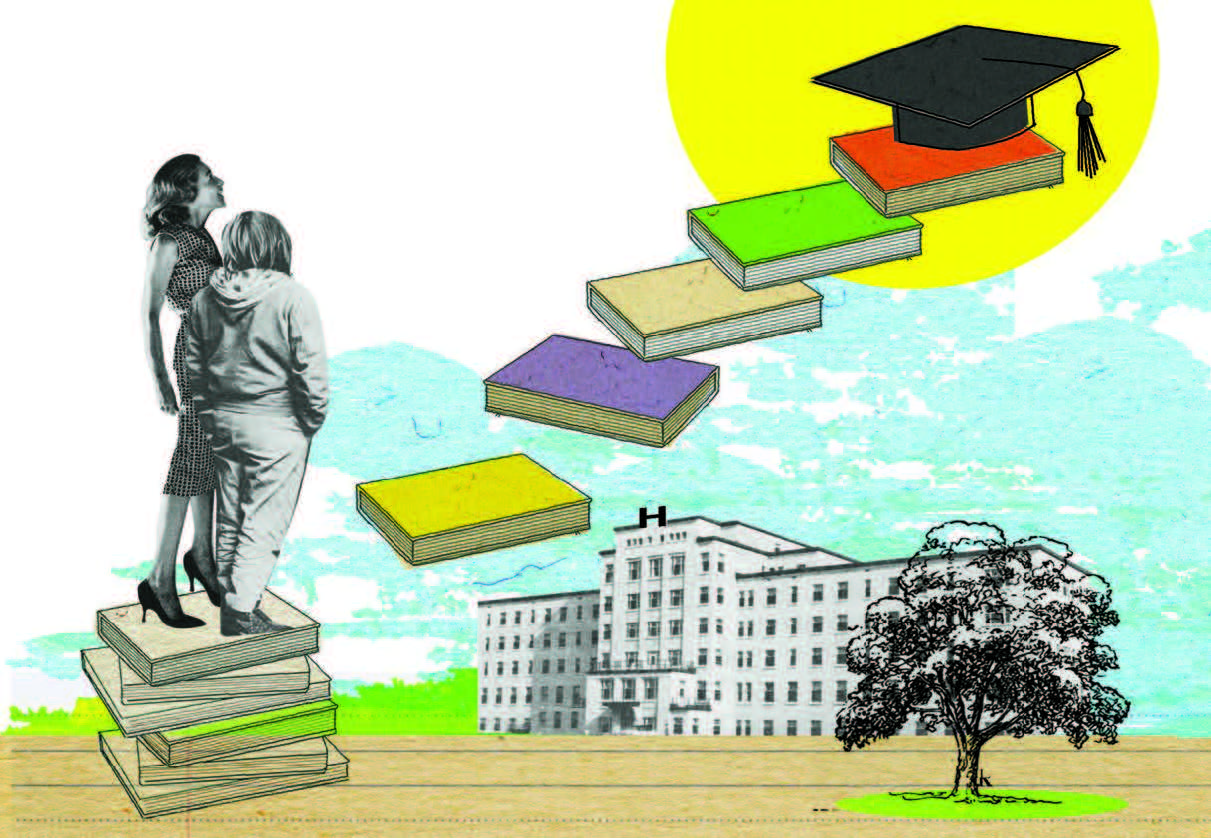Share this page
By Stuart Foxman
Illustrations: Katy Lemay / Anna Goodson

For thousands of students across the province, receiving a public education doesn’t always mean attending a community school — it can mean a community of specialized schools. These Section 23 and 68 programs, under the Education Act, serve a variety of students who might otherwise be unable to attend a typical classroom.
Section 23 programs are operated by school boards for high-risk students. The programs run in settings like children’s mental health centres, hospitals, residential/group homes, detention/correctional facilities, community schools, and other intensive care and treatment environments.
How do the teachers in these settings approach their role, and what valuable lessons do they have for their colleagues? Read on to find out.
Section 68 programs are for children with multi-complex medical needs, beyond learning disabilities. The core programs are housed in children’s treatment centres. Teachers are either employed by a separate school authority for a centre, or seconded for short- or long-term periods by their home board.

At the Hospital for Sick Children (SickKids) in Toronto, Brad McLeod, OCT, is a teaching professional, not a health-care professional. Yet his work, in its own way, is also vital to the children’s healing.
These are children who are getting dialysis or cancer treatments, in intensive care, awaiting transplants, struggling with eating disorders, and facing other ailments. McLeod refers to them all as students, never patients. Do they resent having school work in the hospital? The opposite is true, says McLeod.
“To these kids, the teacher is an escape from dealing with medical issues. There are scary aspects to what they’re going through, so this is the only normal part of their day.”
“To these kids, the teacher is an escape from dealing with medical issues. There are scary aspects to what they’re going through, so this is the only normal part of their day.”
There are 10 Toronto District School Board teachers at SickKids: six elementary, three secondary (including McLeod) and one French. They teach the curriculum offered at the students’ home schools, using similar books and resources, no matter which board the student is from.
Instruction occurs in a classroom or at the child’s bedside. Teachers can get involved as soon as a child is medically stable. Sometimes, children have just a short stay, but the teachers also provide report cards for children who’ve been hospitalized at SickKids for most of a school term.
The secondary teacher never dwells on the students’ medical issues. Once you get past the fact that you’re teaching in a hospital, he says, you have the same mindset as any teacher.
McLeod has two rules. One, don’t give students a sense that they are doing anything wrong. “I always put it back on me, like I must be showing this to you in a way that’s not working,” And two, “Never let them feel they can’t succeed.”
Having taught for 28 years in elementary school, high school, adult education and a mental health centre, McLeod calls the SickKids assignment — which he has held for 19 years — “one of the best jobs you can have in the TDSB.”
The children’s determination and good humour, even in the face of medical crises, inspire him. McLeod recalls one teen he first encountered in the ICU, who had a major procedure. He worked with this student on Grade 11 sociology, psychology and anthropology, and organized a course online. The student wouldn’t accept anything that would ease the workload.
“I never cease to be humbled by the students I work with.”

Many teachers keep artwork from students. Amy Shannon, OCT, remembers one drawing that depicted a rainbow and a bird. What did the student mean? “She had become hopeful,” says Shannon.
Giving hope is one of Shannon’s goals as a teacher serving the Child and Adolescent Mental Health program at St. Joseph’s Health Centre in Toronto. These young people have been admitted through the emergency department. They stay anywhere from a few days to a few months, averaging two weeks.
As Shannon notes, anyone can struggle with mental illness. Students at St. Joseph’s fit all socio-economic groups, cognitive abilities and ages — as young as four.
Shannon teaches students from the in-patient unit. St. Joseph’s also has a hospital classroom for outpatients. After the children are medically assessed, Shannon interviews them. She sees where they’re at academically and arranges to get their school work.
Every morning from 8:30 a.m. to 10:00 a.m. Shannon is on medical rounds as part of an interdisciplinary team comprising doctors, nurses, child/youth workers and social workers that discusses each child. Then the school portion of the day starts.
Shannon’s classroom is like a one-room schoolhouse encompassing JK to Grade 12. She rotates between eight students to assess literacy and numeracy, fill gaps with those areas and executive functioning skills, and assist with the regular lessons.
“The minute they come in, I’m thinking of the transition back to their home school or to an alternative program,” she says.
Shannon, a Toronto Catholic District School Board teacher, has been at St. Joseph’s for 15 years. She’s trained in Special Education and guidance, along with teaching posts in community schools, and once taught for the Trillium Demonstration School for students with severe learning disabilities.
What impact can she make in the short period children are at St. Joseph’s? “It’s important they have coping strategies that are better than when they came in, and understand where they’re going with academics,” says Shannon.
Many of these students have been disconnected from school. Yet when they feel comfortable “they can be quite joyful,” Shannon says. Just think of that image of a rainbow and bird in flight. The most rewarding signs for her have little to do with tests or report cards. “It’s seeing a shift in their perspective,” she says, “that there’s a life worth living and they have a future.”
Earlier this year, Danièle Lafrenière, OCT, read her young learners the tale of a penguin who discovered he was pink. At first he isn’t happy, but ultimately he and his friends accept that everyone is different.
The story resonated with the kindergarten students who Lafrenière teaches at the Ottawa Children’s Treatment Centre School. The centre provides specialized care for children with multiple physical and developmental disabilities.
Lafrenière, on secondment from the Conseil des écoles catholiques du Centre-Est, has spent four years here. She teaches all of the academic curriculum subjects to the francophone students. Her attitude: “Empower students by giving them many opportunities to be risk takers and find their own way.”
She describes a student who was learning to use a slide. This student had an orthotics brace, so had to master the task in a unique way. “Doing it different is OK, and you can achieve it,” Lafrenière says.
All of the students have a differentiated plan. Lafrenière taps into the full range of learning modalities, keenly aware of how each student learns best by seeing, hearing, moving or touching.
She knows, too, that parents can be anxious about leaving their children, who can seem highly vulnerable, in a school for the first time. Lafrenière not only respects those feelings, she has a particular insight into how the parents and children might be thinking.
This is Lafrenière’s second career. Her mother was a Special Education teacher and her father a school principal. She always wanted to be a teacher, but ended up working in administration for a community health centre.
Lafrenière has four children and when her third was born, a girl with special needs, she stayed home to focus on her development. When she thought about returning to work, she knew it was time to change careers and finally become a teacher. She hoped to work with children with disabilities. This is Lafrenière first teaching post.
“I was truly meant to be at this school,” she says.
What satisfies her? “When parents know their children are safe and happy, that learning is happening in a trusting environment.”
Along with readying the children for Grade 1 in a community school, Lafrenière wants to prepare them to be advocates for themselves. “Every child can be independent, with no limit to their learning.”
George Karambelas, OCT, has had an unconventional career path. After graduating from teacher’s college, he switched gears and became a corrections officer. He eventually got a teaching job, and pursued additional training in Special Education and guidance.
Realizing he was drawn to working with at-risk students, he found teaching work at a youth detention facility and a Hamilton jail. Now Karambelas, a Hamilton-Wentworth District School Board teacher, is on the school staff at the McMaster Children’s Hospital’s Child and Youth Mental Health Program.
“This isn’t for everybody,” says Karambelas. Yet it’s precisely the chance to work in a challenging environment, with students in crisis, that invigorates him.
Students in the McMaster program are in Grade 1 through high school. Karambelas works with the in-patient group. The day includes two 55-minute academic periods. “We make sure they’re not falling behind. We’re trying to get them back, and we work with the home school to bridge properly,” explains Karambelas. For example, he might talk to that school about ensuring future accommodations, such as a resource learning room or independent learning.
That’s the practical part of the transition. Karambelas is often consulted by the occupational therapist and the whole clinical team on the emotional part to help students deal with the anxiety of returning to school, and how to answer questions from peers about their absence.
He knows these students can be judged. “Mental health, unfortunately, still has a stigma,” says Karambelas.
Teachers who see young people daily are often in a position to notice mental health issues. Karambelas hopes his
teaching colleagues are alert to the signs and can be a resource for students who are struggling.
Students can face challenges at school for many reasons — mental illness is just one. Here’s what Karambelas finds important, which is instructive for any teacher: Help students find something they can latch onto, and build on that.
“These students need to feel good about the things they do. We all need that. When you don’t feel good about yourself, you can start to think you’re not good at anything, and that starts a spiral.”
He is forever impressed by how his students can realize their potential with the help of medication, therapy, the school and other supports.
“When you see students come in with what they’re going through, the thrill of seeing them come out the other end is amazing.”

In her kindergarten class, Deborah Hayne, OCT, is using a puppet theatre to play restaurant. The students pretend to order food and provide service. They do it with a single-message device, which includes questions and answers that Hayne has recorded. It’s a lesson in communication — for children who have trouble doing just that.
At Niagara Children’s Centre School in St. Catharines, Hayne teaches 12 students, most non-speaking or with unintelligible speech. The school is part of a treatment centre for children with physical, developmental and communicative delays and disabilities.
After teaching Special Education in a community school, Hayne joined Niagara Children’s Centre School. She approaches the kindergarten curriculum and play-based activities like a teacher would in any school, only relying on assistive technology.
For instance, a device called GoTalk includes nine messages on each of five topics. They’re recorded on an overlay of visuals, so children can communicate at the touch of a button. Other times, they might choose between two pictures on a board, or string together simple phrases on an iPad.
Hayne appreciates the chance to collaborate with speech-language pathologists, occupational therapists and physiotherapists, and devise objectives as a team. She encourages her colleagues in community schools to reach out for assistance from their boards to
help Special Education students. “You don’t have to do it all by yourself.”
Any teacher can emulate Hayne’s approach: “Make learning fun and exciting. Motivation is the key to success.”
She has more advice for peers. “We have to be careful as educators. When you see a child not speaking, don’t assume they’re not smart or incapable of learning with their peers. That’s such a miss. Every individual has capabilities.”
For many reasons, students can disengage and be silent in the classroom. Help them to find their voice, says Hayne — in her case, literally.
She describes one little boy who was overwhelmed when he enrolled. It was only in the spring of his first year in JK that he started speaking in single words. One night at home, at age four, he called out “mom” for the first time. This year, on the first day of SK, he ran through the door and said, “Love you Hayne!”
“He’s now speaking in small sentences,” says Hayne, “I want the sky to be the limit for him.”

What does it mean to get an education? The definition has evolved for Janice Karlinsky, OCT. It could be seen as a path from elementary to secondary to post-secondary. Her view differs. “Education is about people engaging with learning, at whatever level they can, and not being afraid to learn.”
Karlinsky teaches students ages 16 to 21 at the Centre for Addiction and Mental Health (CAMH) in Toronto, a leading teaching hospital and research centre in the field. Its offerings include clinical, support and rehabilitation services, from assessment, to early intervention, to residential or day treatment.
At her site, Karlinsky is one of two Toronto District School Board teachers. The students are primarily outpatients. Karlinsky, who has worked with CAMH since 1995, teaches English, history and art. Her colleague teaches math, science and phys.ed.
Many students here have had negative school experiences. A history of failure, coupled with serious mental health issues, “is a huge barrier to learning,” says Karlinsky.
She starts with the philosophy that wellness comes first. “Without being well, no student can learn — in any school. For our students, it’s a much larger struggle.”
Karlinsky adds that “We’ll treat you with dignity and respect. We’re not judgmental; we’re here to work with you so you achieve your goals.”
The learning spaces don’t resemble classrooms. Instead, there are office chairs and tables. “I want this to feel like a professional learning environment, not like a high school,” says Karlinsky.
“Students need to be empowered,” she continues. “You can’t make anybody do anything. They have to be engaged to buy into the process.”
In this school, success means different things. The students often go forwards and backwards, explains Karlinsky, and that’s OK.
“We want them to feel more confident about learning and take risks in learning. So the minute they see something they don’t know, they don’t say ‘I can never learn that.’ They’ll ask.”
Some students earn enough credits to graduate high school at CAMH. Others might transition back to a community school. For Karlinsky, that’s not necessarily the focus. What’s a good day for her students? “They feel pleased they’ve accomplished something, want to do more, or are just happy.”
Karlinsky has other hopes for these youth beyond their formal education. “I want a place for them where they feel accepted as part of the community, where they have people who care for them and about them.”